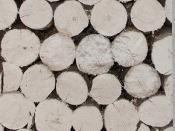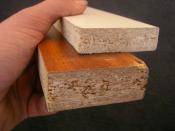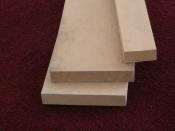Manufactured sheet materials were developed for a variety of reasons. These include its cost to develop, manufacture, transport and produce. The sizes in which it is manufactured in are standardized therefore mass produced. Environmental issues are constantly being addressed as the plantation from which the pine comes from changes. Manufactured sheet materials are cheaper to make, therefore cheaper to buy. They are made from the off cuts of solid timber, usually pine, therefore using recycled resources. Manufactured sheet materials have many qualities that make it an ideal replacement for timber. It is dense, flat, stiff, has no knots and is easily machined. Its fibers, chips or particles provide dimensional stability without a primary "grain" (as is the case with timber).
The properties of manufactured sheet material are it is cheap, environmentally friendly, comes in large sizes and is made from recycled timbers. Advantages of manufactured sheet materials over solid timbers are things such as it is grain and knot free and each sheet is guaranteed to be the same colour, therefore in some designs better looking.
It warps much less due to atmospherical changes and does not dry out like most timbers. However manufactured sheet materials have disadvantages over solid timbers. They are not treated, have raw edges and are not water proofed. Manufactured sheet material swells easily, don't hold screws well and it is harder to patch.
All sheet materials are produced in a simular way, each using pine as their raw material and then be mixed with glue, heated and compressed. Particleboard is made by flakes of pine that have been cut to size and dried. The flakes are then mixed with urea-formaldehyde glue and laid out on stainless steel plates and pressed. MDF is made from chips of pine that have been steamed rather than flakes.


